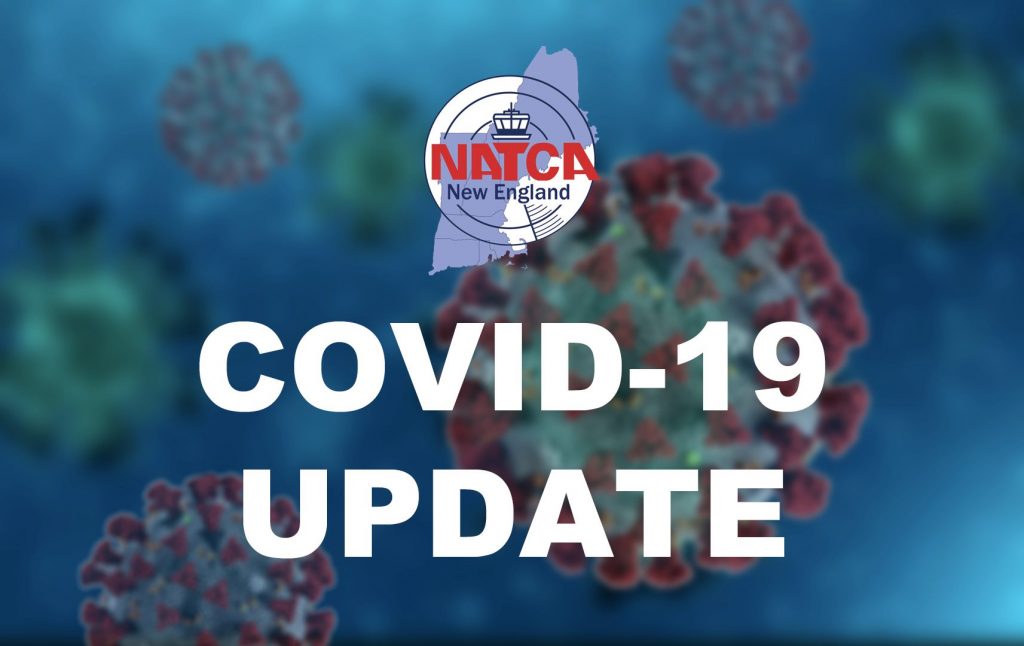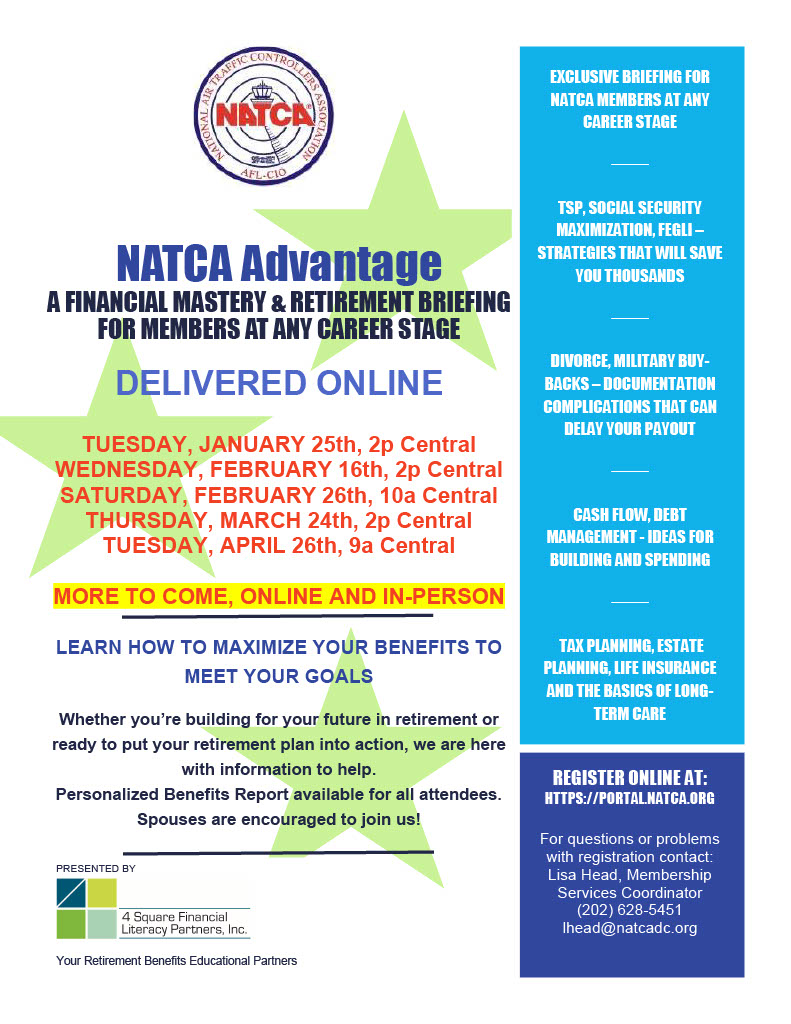
January 2022 New England Bi-Monthly Regional Update #2
From Bryan Krampovitis, NATCA New England ARVP

In this update, we are launching the “FacRep Corner”. Going forward most updates will have an article written by one of the FacReps in the New England Region. Topics in this section will be about an Article in our Contract or National Constitution they believe is worth highlighting. The FacRep corner is meant to give perspective from all the different facilities we have in New England: from the large Center and the TRACONs, to our smaller stand-alone towers. We hope hearing the different ways these documents are executed throughout the region sparks discussions within your own building that lead you to positive ideas and changes. All of our facilities have things they do well while also having things that could be improved upon. Let’s share that information so we can all do better!
I want to stress the importance of wellness checks before reporting to work. Not only do wellness checks help us keep our co-workers and their families safe and healthy, but they are also required before entering the building per our agreement with the agency. This week during the monthly Grievance Review Team telcon, multiple regions reported that the agency is preparing to take steps to discipline employees coming to work with symptoms associated with COVID-19. We have not seen this attempted in New England yet, but we have had a handful of cases where the Agency questioned an employee’s report of symptom onset versus their last worked shift. We all know when we aren’t feeling well, even if it is only slightly “off”. Do your co-workers and yourselves a favor, play it safe, stay home, and rest up if you are sick.
We are going to have a few more weeks of high case numbers and this was expected coming out of the holiday season. If we all do our part maintaining social distance and completing wellness checks, we can plan to get through winter and start off spring with these COVID-19 outbreaks in the rearview.
Collaboration
From Curt Fischer, Collaboration Facilitator, Eastern Service Area North, A90

As I write this update, for the first time this year the cumulative number of daily COVID-19 ATC Restricted from Duty personnel (CPC, CPC-IT, OS) came in lower than the previous day. Let us hope that this is a good sign of things to come and not simply an anomaly in what has seemed like an unstoppable trend upward. I am growing impatient with waiting to begin working towards our New Year’s Resolution of returning to your buildings in person and hearing from members firsthand.
The current situation unfortunately remains bleak. For the first time ever, gating criteria for every facility in the NAS turned red on January 7th. This latest surge has resulted in OJT at A90, ZBW, and PVD being suspended. BGR, BOS, Y90, BDL, and MHT training that cannot be accomplished socially distanced has also been suspended.
COVID-19 has been hitting us hard. So hard that even with doubling our efforts on JCAT (Joint Crisis Action Team) calls we began to fall behind. At noon on January 7, the JCAT system had to be reset to allow the system to catch up. The heavy caseload simply became overwhelming.
Regionally, this month, we doubled our weekly FacRep calls, distributed updated CA-1 guidance to members, and developed and distributed out a COVID-19 member checklist (which is also linked below) to help our members better navigate the confusing onslaught of information. We have also added a “FacRep Corner” feature to our bi-monthly updates. We hope you enjoy this new section. This is an opportunity for your facility representatives to take turns exploring topics of their choosing with you.
I hope you and your families stay safe and healthy. If you are sick, I wish you a speedy recovery. We pledge to keep you updated and informed as guidance continues to evolve rapidly.
COVID-19 CA-1 Corrected Information
From Steven Spiller, NATCA New England OWCP Rep, BOS

In the January 1, 2022 Regional update, the date of a positive COVID-19 test was identified incorrectly as the start of the 30-day clock for COP eligibility. As mentioned in the November 1, 2021 Regional update, as far as the DOL is concerned, the date of injury is the determining date. And in this case, as posted on the NATCA National site (https://www.natca.org/covid-19-resources/): Your date of injury is your last duty day before your positive test result.
As for testing, I now have a few reports in the region that the DOL is denying claims where the testing evidence isn’t verifiable by a third party (read OTC at-home tests which have become more available and popular recently especially with the coming new requirement for them to be covered by health insurance).
To ensure the fewest problems with claim acceptance, the National OWCP Committee still recommends that you get a point-of-care test for covid-19, e.g., a test performed by a third-party medical provider. However, the volume of people seeking covid-19 tests is overwhelming and may be for the next several weeks, making it more difficult for BUEs to obtain a timely point-of-care test.
We have recommended the point-of-care test over an unsupervised home test because it offers independent validation of the date and time when you tested positive for covid-19, fixing your date of injury for DOL. It is possible to supplement a home test result with documentation from a primary care physician, the RFS, etc., but if DOL doesn’t recognize your test as valid for this purpose, it is likely that too much time will have passed for you to remedy this.
However, there are options for independent validation of home tests by third-party medical providers. For example, Abbott makes an at-home diagnostic test called BinaxNOW. In partnership with another company called eMed, BinaxNOW allows users to self-test in a virtual visit guided by an eMed employee, by using the eMed portal and a companion app called NAVICA. The users will need access to a smartphone, personal computer, Internet service and proof of identity to use these tests. With these tests, the claimant functions as his or her own technician, performing the swab and waiting for the result while the provider’s virtual proctor observes. Afterward, the provider validates the observed result with an email and/or update to the claimant’s user profile.
Again, the Committee recommends the point-of-care test over the alternatives. However, if you can’t get a point-of-care test promptly and you have a choice of a virtually proctored home test and one which isn’t, the Committee believes that the virtually proctored home test is the stronger option for proving an OWCP claim.
There may be other products that work similarly to the BinaxNOW-eMed-NAVICA product family. The Committee is not endorsing BinaxNOW-eMed-NAVICA or any specific diagnostic test, nor are we in a position to walk BUEs through using these tests. Please contact the relevant companies with test-related questions or your primary care physician with any medical questions.
Below are some links for the BinaxNOW-eMed-NAVICA product family. A YouTube of someone using this to meet travel requirements for a cruise is also included.
https://www.abbott.com/corpnewsroom/diagnostics-testing/new-at-home-covid-test.html
https://www.youtube.com/watch?v=3EH5uaggE3Y
NATCA New England leadership has developed an interactive COVID-19 checklist that provides one-stop guidance on current COVID-19 protocols.
You may use this checklist if you have symptoms of COVID-19 and/or you were notified of being in close contact with someone positive or presumed to have the virus.
This checklist is a “living document” and will be updated with new guidance anytime protocols are changed. Please save the link below as it will be continuously cross-checked and verified.
Interactive COVID-19 Checklist
Note: This checklist is a Google Slides presentation. If you do not navigate through the checklist using the color buttons as instructed (i.e. if you just click randomly on the slide), it will not function as intended.
FacRep Corner
From Steve Brown, PWM Facility Representative

Under the Finance section in the Standing Rules of the NATCA National Constitution sits SRF-14–NATCA Education Reimbursement Fund. This little-known and hardly used benefit to the membership was recently amended at the 18th Biennial convention in Houston.
Under the passed amendment, active members in good standing may receive up to $5,000 per calendar year in reimbursed funds to obtain a Bachelor of Labor Studies degree, or any other educational course or certificate as deemed appropriate and approved by the National Executive Board from any NATCA-approved institution or program. There is a total of $50,000, which may not be exceeded, set aside for this program each year.
Historically, very few members have taken advantage of the fund. Over the past nine years on average, only approximately $19,000 has been awarded out of the $50,000 available. 2019 and 2020 only saw 9 members take advantage. The largest participation, which took place in 2012, had 12 members reimbursed for $25,636.
Members looking to take advantage of this program will be asked to submit a National Voucher, along with some information about your class and degree to your RVP. Once received your RVP will submit your voucher at the next National Executive Board Meeting for approval. More information can be found here.
An educated union is a strong union, and in today’s day and age of online education, it’s never been easier to get to class. George Shaw, an Irish playwright, and political activist once said, “The educated man is a greater nuisance than the uneducated one.” If you’re looking for a way to strengthen your union, better yourself, or simply stir up the pot, take a look into this program and get involved.
Drug & Alcohol Committee
From Jim Basford, NATCA New England DAC Rep, A90
Is there a limit to the number of people that can be drug tested on a given day? Would you know what it is or where to find that information?
Well, here is an excerpt from DAC Bulletin #4 which details an infraction by ZBW management a couple of years ago and provides guidance on what is expected:
“NATCA arbitrated a grievance at Boston Center (ZBW) involving a random drug test where the FAA, after realizing it had already tested 24 employees (the maximum number for the day according to the test list) decided to test two additional employees because the Agency realized it had mistakenly skipped over their names on the test list.
The Arbitrator sustained NATCA’s grievance, holding that the Agency’s conscious decision to test 26 people at ZBW violated Article 73 of the 2016 Collective Bargaining Agreement (Slate Book), DOT Order 3910.1, and the DOT Drug and Alcohol Testing Guide.
Article 73, Section 2 of the Slate Book provides that “the Agency shall advise the Principal Facility Representative, or his/her designee, of both the maximum number of employees to be tested and the time parameter of the testing period.”
If during testing the Agency collects a sample above the maximum number permitted as stated on the test list, the Facility Representative or his/her designee should inform the Site Coordinator and insist that the sample be destroyed. If the Site Coordinator will not dispose of the sample, immediately contact your Regional Vice President for assistance in making sure that the Agency destroys the improperly-collected sample before sending them forward for testing.”
Remember, when it comes to drug and alcohol testing, you as a member must request representation, so please do so!
This is one of the many items that are covered in the Drug and Alcohol Representative class. NATCA strives to have educated representatives, so you have an interest in being trained as a Rep for this, please reach out to your FacRep.
If you have any Drug & Alcohol related questions, you may contact me at 603-203-9945.


